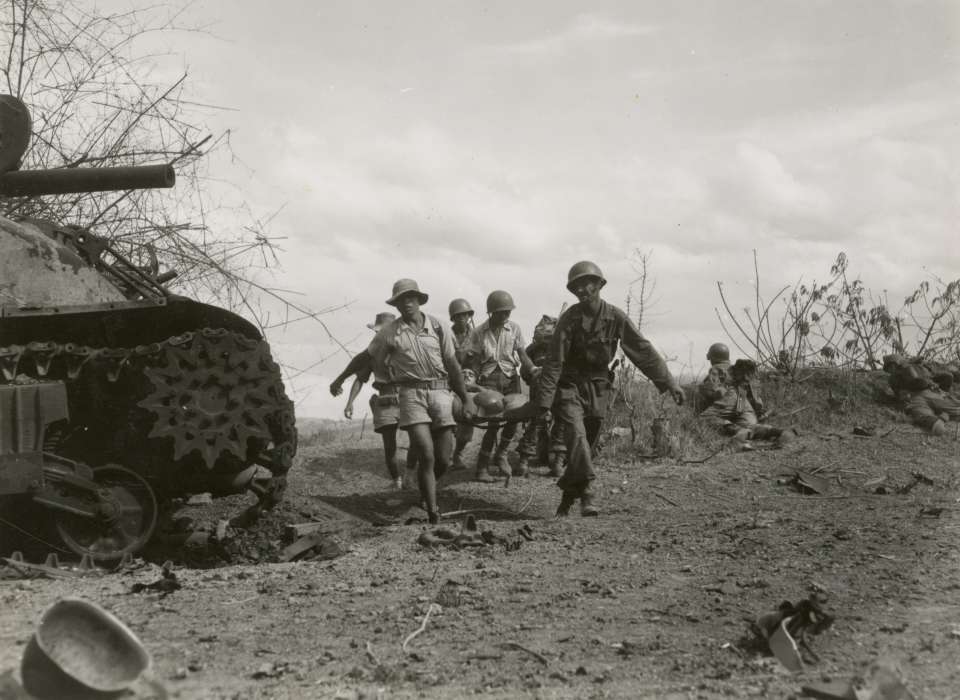Top image: "Filipino guerrillas help carry US wounded." [1945]
Accession Number 2008.354.381
In 2009, the US Congress designated October as Filipino American History Month, a monthlong commemoration and appreciation for the Filipino experience throughout American history stretching as far back as 1587. Today, about 4.1 million Filipino Americans make up the second-largest Asian American ethnic group in the United States.
In recognition of Filipino American History Month, The National WWII Museum wishes to highlight a small but important part of the Filipino American experience tied to World War II, the defense of the Philippines by Filipino soldiers who served under US military command.
The United States’ involvement in the Philippines stretches back to before World War II with the commencement of the Spanish-American War in 1898. The Treaty of Paris, which concluded hostilities between Spain and the United States, surrendered Spanish control of the Philippines to the United States as a colony. In 1935, the Philippine Commonwealth was established as a US protectorate and was intended to be a fully independent nation after a 10-year transitionary period. Because they resided in what was still US territory, Filipinos were US nationals by law but not afforded the same benefits, rights, and privileges as US citizens.
With Japanese-US relations deteriorating, President Roosevelt issued a Presidential Order on July 26, 1941, which nationalized the Philippine Commonwealth military and placed them under the command of General Douglas MacArthur in the newly formed US Army Forces in the Far East (USAFFE). This order stood for the remainder of World War II, and some 260,000 Filipinos served under US command in the Philippine Commonwealth Army, the Philippine Scouts, and even guerrilla units during Japanese occupation. They played a critical role in the Philippines’ defense and ultimate liberation.
Take for instance the example of Jose Calugas. Born in the Philippines, Calugas served in the Philippine Scouts and went above and beyond the call of duty in the face of Imperial Japan’s aggression. Calugas helped defend the Philippines islands. He was captured by the Japanese and marched alongside Americans soldiers in the Bataan Death march. As a POW, Calugas joined a guerrilla cell to resist Japanese occupation. Calugas was awarded the Medal of Honor for his service following the Philippines’ liberation.
Friend of the Museum Cecilia I. Gaerlan has written about the struggle faced by Filipino soldiers alongside regular US troops during the defense, occupation, and liberation of the Philippines. She also writes of the struggles faced by Filipino veterans following the war with the First Supplemental Surplus Appropriation Rescission Act of 1946, which denied Filipino veterans the benefits entitled to them for their WWII service in the Philippines, including full US citizenship. Despite this, some Filipino WWII veterans still came to the United States and were able to eventually obtain full US citizenship through continued service with the US Armed Forces. Jose Calugas, who continued to serve in the US Army through the occupation of Okinawa, was one of them.
Despite the legal differences between US national and citizen, Filipino American History Month honors the service of both Filipino Americans and Filipinos for their service with the US Armed Forces during World War II. Citizen or otherwise, the service of Filipinos during the conflict is an integral component to commemorating Filipino American History Month. The original 2009 Congressional resolution that designated October as Filipino American History Month reads:
“Whereas Filipino-American servicemen and servicewomen have a longstanding history of serving in the Armed Forces, from the Civil War to the Iraq and Afghanistan conflicts, including the 250,000 Filipinos who fought under the United States flag during World War II to protect and defend the United States”
In 2016, these same Filipino veterans were awarded the Congressional Gold Medal for their WWII service. The National WWII Museum is proud to honor the experiences of those Filipino American citizens and Filipinos who served on the battlefield and on the Home Front as a part of our national experience. You can learn more about this collective experience in the articles below and by visiting our campus.
For more information on the history of the Philippines from before, during, and after World War II, see Ricardo Jose’s article on Philippine independence.
By Andrew Good
Andrew Good is the project manager at the Jenny Craig Institute for the Study of War and Democracy and obtained his Masters of Arts in History from the University of New Orleans in May 2022.
Cite this article:
MLA Citation:
APA Citation:
Chicago Style Citation:






![Max Fuchs, New York City cantor, sings as Rabbi Sydney [sic] Lefkowitz, Richmond, VA, conducts the first Jewish services from Germany.](/sites/default/files/styles/max_650x650/public/2025-10/image1.jpg)

